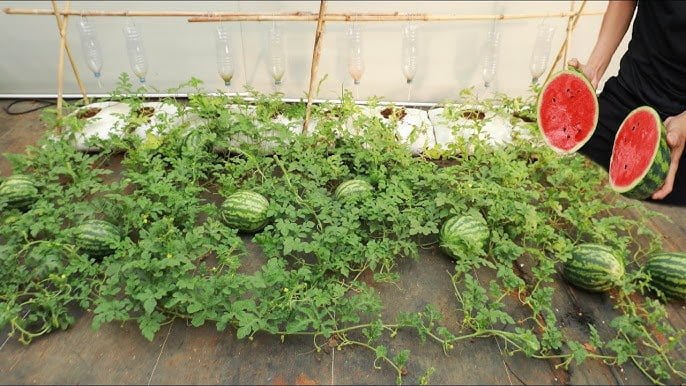Growing watermelon in a container at home can be a rewarding experience. While watermelon plants can be quite large, there are compact varieties and techniques that make it possible to grow them in containers. Here’s a step-by-step guide on how to grow watermelon in a container:
Materials you will need:
- Container: A large container with a minimum capacity of 10-15 gallons per plant is ideal. Make sure it has drainage holes at the bottom.
- Potting Mix: High-quality potting mix or a mix of garden soil and compost.
- Watermelon seeds or transplants: You can purchase watermelon seeds or small watermelon plants from a nursery.
- Support: Trellis or stakes for support, especially if you’re growing a vining variety.
- Fertilizer: A balanced, slow-release fertilizer or organic fertilizer suitable for vegetables.
- Mulch: Organic mulch such as straw or wood chips (optional).

Steps:
- Choose a suitable container: Select a large container with adequate drainage. The size of the container will determine the number of watermelon plants you can grow. Ensure it receives at least 6-8 hours of sunlight per day.
- Prepare the potting mix: Fill the container with a well-draining potting mix or a mix of garden soil and compost. Leave about 2-3 inches of space at the top.
- Plant the watermelon seeds or transplants: If using seeds, plant them about 1 inch deep in the center of the container. If using transplants, dig a hole in the center of the container deep enough to accommodate the root ball of the transplant.
- Water thoroughly: After planting, water the container thoroughly to settle the soil and provide initial moisture to the seeds or transplants.
- Provide support: Watermelon vines can be trained to grow vertically to save space. Install a trellis or stakes to support the vines as they grow.
- Fertilize: Apply a balanced, slow-release fertilizer or organic vegetable fertilizer according to the package instructions. Watermelon plants benefit from regular feeding.
- Mulch (optional): Applying mulch around the base of the plants can help conserve moisture and reduce weed competition.
- Watering: Watermelon plants require consistent moisture. Keep the soil evenly moist, but avoid overwatering, which can lead to root rot. Water the soil at the base of the plant rather than overhead to prevent fungal diseases.
- Pollination: Watermelon plants require pollination for fruit production. If you have limited pollinators in your area, you can hand-pollinate by transferring pollen from the male flowers to the female flowers using a small brush or cotton swab.
- Pruning: To control the size of the plant and encourage fruit development, you can selectively prune the vines. Remove any excess vines and leaves that are not contributing to fruit production.
- Harvest: Watermelons are ready for harvest when they sound hollow when tapped, the skin changes color, and the tendrils near the fruit turn brown and dry.
- Enjoy your homegrown watermelons: Once your watermelons are ripe, cut them from the vine, slice, and enjoy!
Growing watermelon in containers allows you to enjoy this delicious fruit even if you have limited space. Be sure to choose compact or dwarf watermelon varieties for better results in containers, and provide the necessary care and attention to help your plants thrive.

